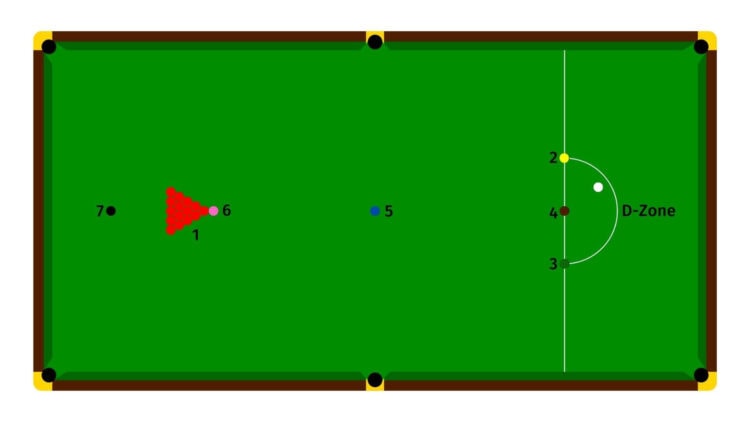
OBJECTIVE OF SNOOKER: Score more points than the opponent by “potting” the correct colored balls.
NUMBER OF PLAYERS: 2 players
MATERIALS: Snooker table, cue stick, 21 colored balls (15 red, 1 pink, 1 yellow, 1 green, 1 black, 1 brown, and 1 blue), 1 cue ball
TYPE OF GAME: Sport
AUDIENCE: 5+
OVERVIEW OF SNOOKER
Snooker is a billiards/cue sport closely related to the game of pool. In this game, players take turns “potting” as many balls as possible by hitting them into any of the six pockets on the edges of the snooker table. Although fundamentally similar to other billiards games, snooker features a uniquely distinct set of rules.
The sport of snooker is said to have originated in Jabulpur, India, in 1875 by British troops stationed in the city. While playing a variation of pool (black pool), English Lieutenant Neville Chamberlain decided to place a bunch of colored balls on the table, subsequently inventing a new game. He then decided on the name “snooker”, a slang term used in reference to new army cadets, because he realized everyone playing his new game was a “snooker” to the game.
Due to the sport’s colonial English origin, Snooker is widely popular in many former British colonies, such as India and Hong Kong. However, competitive snooker has been dominated by British players since the sport’s inception, with few foreign competitors ever having won any major competitions.
SETUP

EQUIPMENT
- Snooker Table: A 12×6 foot rectangular table with six pockets—one in each corner and one in the middle of each long side. A long “balk line” is drawn near one end of the table, with a small semicircle drawn next to it (known as the “D”).
- Cue Stick: A full-length snooker cue stick is generally 57 inches in length, which is a few inches shorter than a common pool stick (59 inches).
- Balls: Snooker requires 21 total balls—a white cue ball, 15 red balls, and one ball of each of the following colors: blue, yellow, pink, red, black, brown, and green. Snooker balls are also slightly smaller than pool balls, with a diameter of 2 1/16 inches.
SNOOKER BALLS
Snooker requires a large selection of colored balls. Each ball serves a particular purpose and is worth a different amount of points:
- White Ball: This is the only ball that the cue stick can contact
- Red Balls: Worth 1 point each
- Yellow Ball: Worth 2 points
- Green Ball: Worth 3 points
- Brown Ball: Worth 4 points
- Blue Ball: Worth 5 points
- Pink Ball: Worth 6 points
- Black Ball: Worth 7 points
At the start of the match, all balls are placed in specific positions. The green and yellow balls are placed directly on the spot where the balk line intersects with the “D”. In between these two balls sits the brown ball all in a straight line.
The blue ball sits precisely in the middle of the table. Near the end of the table opposite from the balk line sits a wedge/triangle-shaped formation of all 15 red balls. At the very tip of this wedge sits the pink ball.
Lastly, the black ball sits even further back from the red ball wedge (still directly in the middle bisecting line of the table).
When red balls are legally scored, they are off the table for the rest of the frame. When a colored ball is legally scored, the ball is placed back in its original spot on the table.
GAMEPLAY

A game of snooker begins with a coin flip to decide which player goes first. The player who wins starting rights must place their cue ball anywhere within the “D”. Using their cue stick, the player must hit the cue ball into the wedge of red balls on the other end of the table. If they manage to pot one of the red balls, their turn continues as they attempt to pot any colored ball of their choice. If they successfully score the colored ball (after hitting it with the cue ball, of course), this process repeats again—red, colored, red, colored.
If the player commits a foul or fails to successfully pot a ball, their turn ends as the other player picks up where they left off.
Once all red balls have been potted, the players must hit each of the colored balls in corresponding order to their point value (yellow, then green, then brown, then blue, etc.). At this point, these colored balls are not placed back on the table after being legally potted. Once the final black ball is potted, the frame ends.
SCORING
As mentioned above, in the rules of Snooker each colored ball is worth between one and seven points.
In a full snooker match, players participate in a predetermined, odd number of “frames”. A “frame” is simply one round. Once all of the balls on the table are potted, the frame ends. A typical snooker match will have between 11 and 19 frames, with a higher number of frames usually reserved for more important matches. The number of frames essentially acts as a “best-of” series, with the first player to play 6 frames of an 11-frame match being the winner.
Throughout a frame, the amount of points a player scores in a given turn is known as a “break”.
RULES AND FOULS
A player can foul depending on their actions or shots while at the table. Fouls result in the offending player’s turn ending, and their shot (that caused the foul) not counting. If after a foul shot the cue ball is snookered then the referee or opposing player may call for a free ball.
Common fouls include:
- Deliberately failing to hit a ball with the cue ball (a “miss” foul)
- Failing to strike the correct ball before hitting any other balls (cue ball hits a colored ball before it hits the targeted red ball)
- Potting the cue ball or an incorrect color (potting a colored ball on a red ball shoot)
- Hitting a ball off of the snooker table
- Hitting a shot with both feet off of the ground
- Hitting a colored ball while the cue tip is still in contact with the cue ball (known as a “push shot” foul)
- Deliberately failing to hit a target ball (a “miss” foul)
- Taking a shot before all balls have stopped moving
- Touching ball with anything other than the cue ball
- Jump shot (the cue ball cannot circumvent another ball through the air)
A “SNOOKER”
Believe it or not, there is actually something known as a “snooker” in the game of snooker. This situation occurs when the cue ball ends up in a spot in which there is no direct path to the target ball that needs to be potted.
For example, a snooker could occur when the cue ball ends up right behind the black ball, with the last remaining red ball lying on the opposite side of the black ball. These situations don’t result in extra points, although they force a player to make a difficult shot to escape the predicament.
A PERFECT GAME
Technically, a player can win a snooker match without the other player even getting a chance. This actually isn’t too rare, as a player simply has to score enough points on their first turn so that there aren’t enough remaining points on the table for their opponent to catch up.
However, a perfect game quite literally doesn’t allow one player any chance to score any points. This is known as a “maximum break”, and is when a player scores 147 points in a single break, potting every ball on the table.
This maximum break requires the player to pot 15 red balls, 15 colored balls, and then all 6 colored balls again in the correct order. While these are no longer incredibly rare like they used to be, maximum breaks require 36 perfect shots in a row, easily making them the peak of achievement in the sport of snooker.
Here’s an example of Ronnie O’Sullivan’s maximum break at the Welsh Open:
Ronnie O’Sullivan 147 break fastest in history
END OF GAME
The player who scores the most break points in a frame is deemed the winner of the frame. The overall winner of the snooker match is the player that wins the most frames.
- 30 GAMES TO PLAY OVER TEXT - April 22, 2024
- 20+ FREE PRINTABLE BABY SHOWER GAMES - April 16, 2024
- 20+ College Party Games for the Best Night Ever! - April 2, 2024